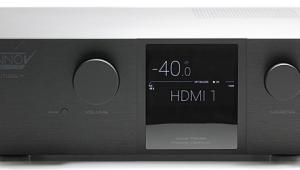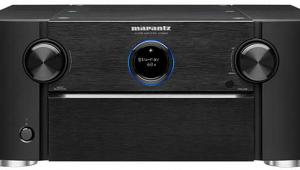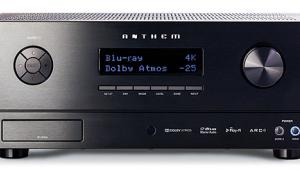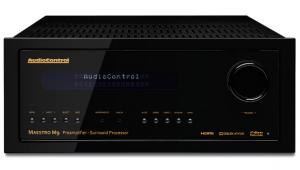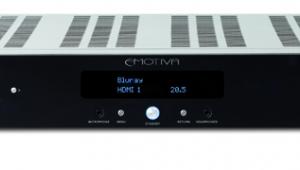I HATE (with a PASSION) this trend! "Let's make a box with a ton of features, but sounds like crap!" ENOUGH! If you are spending $2000 on a pre-amp/processor, shouldn't it SOUND GOOD? Onkyo/Integra has been sliding down the slippery slope the past few years...tacking on features, and paying next to NO attention on their sound quality. I would recommend taking a pass on this one...HDBaseT and 4k upscaling is nice, but if you are buying separates, you should at least get something that sounds better than the competition's AVRs!
Integra DHC-60.5 Network A/V Controller

AT A GLANCE
Plus
HDBaseT audio/video via CAT5e/6
4K upconversion and passthrough
Feature packed and futureproof
Minus
Lackluster sonics
THE VERDICT
The futureproof, feature-packed, and easy-to-operate midline DHC-60.5 is a custom installer’s dream, but it falls short on sound quality.
Integra’s new THX Ultra2 Plus–certified DHC-60.5 A/V controller—one of the first to offer HDBaseT connectivity—is clearly intended for the custom install market. But with its generous feature array and ease of operability, the $2,000 midline offering will no doubt also attract its share of retail consumers.
For those unfamiliar with HDBaseT, this is a relatively new technology that allows a variety of different audio/video signal types, including HDMI and various control signals, to travel together along a single inexpensive CAT5e/6 cable, the kind typically used for Ethernet connections. The DHC-60.5’s built-in HDBaseT technology allows custom installers (or you) to send up to 4K resolution video and high-resolution digital audio (among other things) as far as 300 feet. Thus, it can be used for a primary display device that’s located well away from the DHC-60.5, or it can be used for either the theater’s second display device or for one of two remote zones.
While the HDBaseT-equipped unit goes where no pre/pro has gone before, it also jettisons the past at warp speed by not including either a 5.1-channel analog input or a second HDMI output, now commonplace among better surround processors and AVRs. So if you’ve got a legacy multichannel analog source (such as my Sony SCD-XA777ES SACD player), you’ll be out of luck. (To its credit, the DHC-60.5 is also “future-proofed” with a decent built-in moving-magnet phono preamp.) Having HDBaseT instead of a second HDMI out also means that multi-display media rooms will require an HDBaseT receiver and a run of CAT5e/6 to the second display. Retrofitting the DHC-60.5 to an existing dual-display theater would mean either a new CAT 5e/6 run for the second display or using the existing HDMI cable and a suitable HDMI splitter.
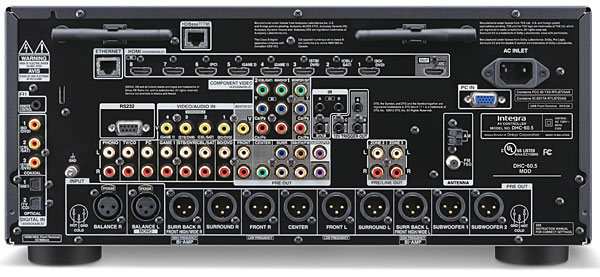
Beyond the advance of HDBaseT, the 7.1-channel DHC-60.5 is more conventionally featured. It offers balanced XLR and single-ended preouts and includes decoding for the now familiar Dolby TrueHD and DTS-HD Master Audio uncompressed formats. There’s also Audyssey DSX processing for adding height or width channels, and that company’s MultEQ XT32 setup and room correction and Audyssey Volume and Dynamic EQ modes. With the 7.1 balanced and single-ended outputs, you can configure either surround back, height, or width channels, but not all three. You can also use the same two outputs to biamp the front channels using the built-in digital crossover network. A second set of subwoofer outputs is provided to feed an additional sub, though it carries the same signal as the main sub out. There are eight rear-panel HDMI inputs and one front input, plus three coaxial and two TosLink digital inputs.
The DHC-60.5 provides both 3D and 4K passthrough and up to 4K upscaling (via its Marvell Qdeo chipset) and allows tweaking of a full range of ISF calibration parameters, which can be used to individually tune each video source in the hands of a skilled technician. (THX recommends setting the output to Through so the screen sees the source’s native resolution. The picture it produced in this setting on both my plasma and JVC DLA-HD750 projector were as good as I’ve seen them—essentially transparent to the source.)
The unit features Bluetooth, Wi-Fi, and iPod connectivity (the latter with an optional dock). It also includes a 40-preset FM/AM tuner as well as a host of Internet-based widgets, including SiriusXM, Pandora, Spotify, Tunein, last.fm, Aupeo!, Rhapsody, and Slacker. The DHC-60.5 is DLNA version 1.5 certified; its onboard DAC decodes files up to 192 kilohertz/24-bit audio.
Setup and Use
Upon initial turn-on and after plugging in the Audyssey microphone, the unit automatically goes into setup mode. By now you probably know that familiar drill. While each manufacturer’s operating system differs slightly, the Audyssey setup basics remain the same. The remote’s Setup button doesn’t access the complete system setup. Instead, it gives you the completed setup’s connectivity and configuration status and allows you to change the most common settings.
Pushing the remote’s Home button accesses the setup toolbox icon, one of five that then appear on your set’s screen. Selecting that icon accesses the full setup menu. The second icon is InstaPrevue, which displays small thumbnail windows that show what’s being streamed to your connected HDMI inputs. The third icon is for firmware updates. The fourth is for Network Service, which is where you access Internet services or stored Windows-based media connected to your home network. The fifth icon is for USB stick media playback via the front-panel USB input.
Overall, despite its unusually complete feature set, configuring and using the DHC-60.5 was relatively easy, including integrating the pre/pro into my Ethernet-wired Internet connection, which is often far more problematic.
Clearly, the idea is to have a custom installer set it all up and then encourage the end user to navigate the preset and configured features. So while setup wasn’t difficult, making some changes was. For instance, while many remote controls allow you to switch Audyssey on and off, the Integra’s does not. Instead, each input is separately configured for Audyssey. Changing that particular input’s Audyssey setting requires you to go into the toolbox—you can’t globally turn it on and off from the remote.
- Log in or register to post comments


Reviews should be used as a guide not as Gospel. I'm not sure what was wrong with his system, but this reviewer got it very wrong. I have been in the high-end audio video business since the 70's, including owning a well respected retail business as well as hosting a radio talk show on the subject. I have also been a studio engineer since the 80's actually creating and mixing audio. I tested both the 60.5 pre-pro and the receiver. The sound is so good from both that I purchased the receiver for my own 11.2 system and have recommended the units for others. It never ceases to amaze me that folks comment on reviews so passionately without ever hearing the stuff for themselves. Shame on you if you have done so.

I moved away from Integra after numerous unsuccessful tweaks and procedures with the DHC-80.2 to achieve a more gentle sound. I was continually either fatigued with the Audyssey XT32 correction or frustrated by a drab and confused sound with direct modes. Like others, I felt like I was wasting a great amp (NAD T955) with the Integra. As popular it is in the lucrative custom installer market, I think Onkyo has lost touch with the end benefit of pleasurable listening and focused on endless specs and features.
I'm currently enjoying Pioneer Elite but very tempted to try Marantz.

This review is why I have remained a fan over all these years. Occasionally your magazine (now including the Sound and Vison staff)reviews a product that does not get glowing and raving reviews; this just proves that you are doing your jobs by providing consumers unbiased and professional journalism. Thank you.

My Integra 80.2 and the newer 80.3 are excellent. So when I saw the review in Sound & Vision I expected the sound would be terrific with lots of new wireless connectivity options.
Instead what we find is they shortcut the audio design. Why? What were they thinking. At least the Editor asked the reviewer to check a second sample to confirm that the original unit was not defective. Then to give it to the best tech guy they have and he concurred.
Bad job Integra. Your reputation is going down hill fast.
For a preamp, sound quality is first, connectivity is third and flexibility is second. Bad...bad...bad.

Re-read the article, the second guy did not concur. In fact he found the sound "brighter". And the reviewer said
"He further compared the DHC-60.5 to the front-end pre/pro section of the new Marantz SR7008 receiver and found both Integras to be distinctly brighter in character, though he was not able to spend enough time to fully compare the more subtle aspects of the DHC-60.5’s sound that I heard in my extended auditions."
That's code for "he did not hear what I heard"
I have tested both the receiver and pre-pro and they sound amazing. Vastly better than any Pioneer Elite or Marantz pieces I've tested. The 60.5's are delicate, dynamic, and make even mediocre speakers sound good. You with your "bad bad bad" comment without ever hearing the units are just describing yourself.

